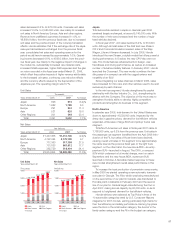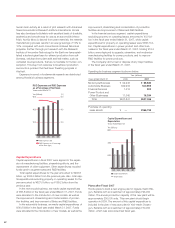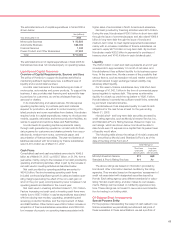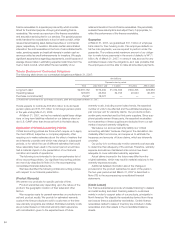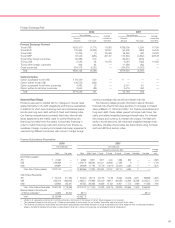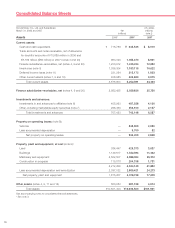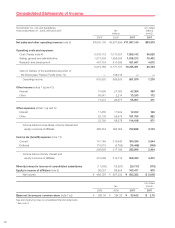Honda 2007 Annual Report Download - page 68
Download and view the complete annual report
Please find page 68 of the 2007 Honda annual report below. You can navigate through the pages in the report by either clicking on the pages listed below, or by using the keyword search tool below to find specific information within the annual report.
66
We believe that our estimated losses on lease residual
values is a “critical accounting estimate” because it is highly
susceptible to market volatility and requires us to make
assumptions about future economic trends and lease residual
values, which are inherently uncertain. We believe that the
assumptions used are appropriate. However, actual losses
incurred may differ from original estimates.
If future auction values for all Honda and Acura vehicles in
our North American direct financing lease portfolio as of March
31, 2007, were to decrease by approximately ¥10,000 per unit
from our present estimates, the total impact would be an
increase in losses on lease residual values by about ¥0.8 bil-
lion. Similarly, if future return rates for our existing portfolio of all
Honda and Acura vehicles were to increase by one percentage
point from our present estimates, the total impact would be an
increase in losses on lease residual values by about ¥0.1 bil-
lion. For operating lease portfolio as of March 31 with the same
prerequisite shown above, the impacts would be immaterial.
Note that this sensitivity analysis may be asymmetric, and are
specific to the base conditions in fiscal 2007.
(Pension and Other Postretirement Benefits)
We have various pension plans covering substantially all of our
employees in Japan and certain employees in foreign coun-
tries. Benefit obligations and pension costs are based on
assumptions of many factors, including the discount rate, the
rate of salary increase and the expected long-term rate of
return on plan assets. The discount rate and expected long-
term rate of return on plan assets are determined based on our
evaluation of current market conditions, including changes in
interest rates. The salary increase assumptions reflect our ac-
tual experience as well as near-term outlook. Our assumed dis-
count rate and rate of salary increase as of March 31, 2007
were 2.0% and 2.3%, respectively, and our assumed expected
long-term rate of return for the year ended March 31, 2007
was 4.0% for Japanese plans. Our assumed discount rate and
rate of salary increase as of March 31, 2007 were 5.2–6.0%
and 2.9–6.4%, respectively, and our assumed expected long-
term rate of return for fiscal 2007 was 6.8-8.0% for foreign
plans.
We believe that the accounting estimates related to our
pension plans is “critical accounting estimate” because
changes in these estimates can materially affect our financial
condition and results of operations.
Actual results may differ from our assumptions, and the dif-
ference is accumulated and amortized over future periods.
Therefore, the difference will be generally reflected as our rec-
ognized expenses and recorded obligations in future period.
We believe that the assumptions currently used are appropri-
ate, however, differences in actual expenses or changes in as-
sumptions could affect our pension costs and obligations,
including our cash requirements to fund such obligations.
The following table shows the effect of a 0.5% change in
the assumed discount rate and the expected long-term rate of
return on our funded status, equity, and pension expense.
Japanese Plans Yen (billions)
Assumptions Percentage point change (%) Funded status Equity Pension expense
Discount rate +0.5/–0.5 –88.1/+99.3 +47.9/–59.8 –5.2/+6.3
Expected long-term rate of return +0.5/–0.5 — — –3.3/+3.3
Foreign Plans Yen (billions)
Assumptions Percentage point change (%) Funded status Equity Pension expense
Discount rate +0.5/–0.5 –43.4/+49.8 +30.7/–35.8 –6.3/+7.3
Expected long-term rate of return +0.5/–0.5 — — –1.8/+1.8
(*1) Note that this sensitivity analysis may be asymmetric, and are specific to the base conditions at March 31, 2007.
(*2) Funded status for fiscal 2007 is affected by March 31, 2007 assumptions. Pension expense for fiscal 2007 is affected by March 31, 2006 assumptions.
Quantitative and Qualitative Disclosure About Market
Risk
Honda is exposed to market risks, which are changes in for-
eign currency exchanges rates, in interest rates and in prices of
marketable equity securities. Honda is a party to derivative fi-
nancial instruments in the normal course of business in order
to manage risks associated with changes in foreign currency
exchange rates and in interest rates. Honda does not hold any
derivative financial instruments for trading purposes.
(Foreign Currency Exchange Rate Risk)
Foreign currency forward exchange contracts and purchased
option contracts are normally used to hedge sale commitments
denominated in foreign currencies (principally U.S. dollars).
Foreign currency written option contracts are entered into in
combination with purchased option contracts to offset pre-
mium amounts to be paid for purchased option contracts.
The tables on the next page provide information about our
derivatives related to foreign currency exchange rate risk as of
March 31, 2006 and 2007. For forward exchange contracts
and currency options, the table presents the contract amounts
and fair value. All forward exchange contracts and currency
options to which we are a party have original maturities of less
than one year.



